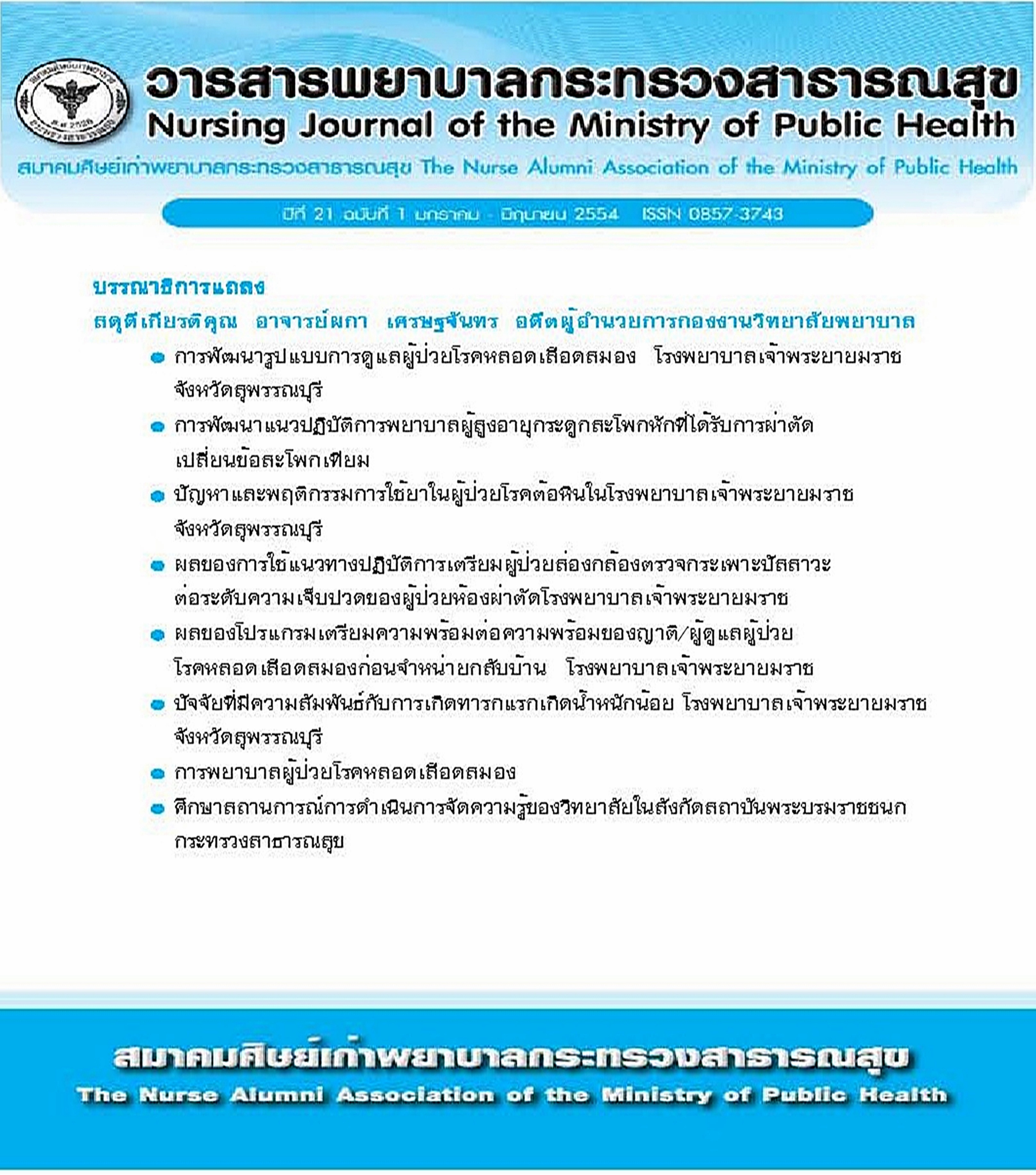การพัฒนาแนวปฏิบัติการพยาบาลผู้สูงอายุกระดูกสะโพกหักที่ได้รับการผ่าตัดเปลี่ยนข้อสะโพกเทียม
Main Article Content
Abstract
บทคัดย่อ
รายงานฉบับนี้ได้นำเสนอการพัฒนาแนวปฏิบัติการพยาบาลคลินิกโดยใช้หลักฐานเชิงประจักษ์ เรื่องการพยาบาลผู้ป่วยสูงอายุกระดูกสะโพกหักที่ได้รับการผ่าตัดเปลี่ยนข้อสะโพกเทียม โดยใช้ Evidencebased practice model ของซูคัพ (Soukup, 2000) เป็นกรอบแนวคิดในการพัฒนาซึ่งประกอบด้วย 4 ระยะคือ 1) การค้นหาปัญหาทางคลินิก 2) การสืบค้นหลักฐานเชิงประจักษ์ 3) การนำแนวปฏิบัติไปทดลองใช้และ 4) การนำแนวปฏิบัติที่ปรับปรุงแล้วไปใช้จริงในหน่วยงาน การศึกษาครั้งนี้ได้หลักฐานเชิงประจักษ์ที่ผ่านการ
ประเมินระดับความน่าเชื่อถือและความเป็นไปได้ในการนำหลักฐานเชิงประจักษ์ไปใช้มีหลักฐานเชิงประจักษ์ ทั้งหมด 23 เรื่อง หลักฐานอยู่ในระดับ A จำนวน 7 เรื่อง ระดับ B จำนวน 6 เรื่อง ระดับ C จำนวน 7 เรื่อง ระดับ D จำนวน 3 เรื่อง บทความวิชาการ 3 เรื่อง ผลการสังเคราะห์ในการสร้างแนว ปฏิบัติการพยาบาลจำแนกเป็น 3 ระยะ คือ ระยะก่อนผ่าตัด ระยะหลังผ่าตัดและระยะฟื้นฟูสภาพหลังได้รับการผ่าตัดเปลี่ยนข้อสะโพกเทียม แนวปฏิบัติการพยาบาลที่พัฒนาขึ้นได้ผ่านการตรวจสอบจากผู้ทรงคุณวุฒิจำนวน 3 คน และนำมาปรับปรุง
แก้ไขแนวปฏิบัติให้มีความเหมาะสม นอกจากนั้นผู้ศึกษายังได้สร้างคู่มือการปฏิบัติตัวสำหรับผู้ป่วยสูงอายุ กระดูกสะโพกหักที่ได้รับการผ่าตัดเปลี่ยนข้อสะโพกเทียม นำไปทดลองปฏิบัติในคลินิกจำนวนผู้ป่วย 16 ราย ผลการปฏิบัติตามแนวทางการพยาบาลนี้ พบว่ากลุ่มตัวอย่างส่วนใหญ่มีอายุเฉลี่ย 72.75 ปี (ช่วงอายุ 61- 84 ปี) เข้ารับการรักษาด้วยปัญหากระดูกต้นขาส่วนคอหัก มีโรคประจำตัวร้อยละ 87.5 โรคที่พบมากที่สุดคือ โรคความดันโลหิตสูง ไขมันในเลือดสูง และโรคเบาหวานคิดเป็นร้อยละ 62.8, 25 และ 12.2 ตามลำดับ สรุป
ว่าแนวปฏิบัติการพยาบาลที่พัฒนาขึ้นนี้สามารถนำไปใช้ในคลินิกได้ โดยสามารถป้องกันไม่ให้เกิดภาวะแทรก ซ้อนหลังผ่าตัด และทำให้ระยะเวลานอนโรงพยาบาลตั้งแต่แรกรับจนกระทั่งกลับบ้านลดลงจากก่อนใช้แนว ปฏิบัติการพยาบาลเฉลี่ยเท่ากับ 17.4 วันเป็น 13.6 วัน และระยะเวลานอนโรงพยาบาลตั้งแต่หลังผ่าตัดจนกระทั่งกลับบ้านเฉลี่ยเท่ากับ 7.75 วัน
คำสำคัญ : แนวปฏิบัติการพยาบาล การพยาบาลผู้ป่วยสูงอายุกระดูกสะโพกหักที่ได้รับการผ่าตัดเปลี่ยนข้อสะโพกเทียม ภาวะแทรกซ้อนหลังผ่าตัด
* พยาบาลวิชาชีพชำนาญการ หัวหน้าหอผู้ป่วยออร์โธปิดิกส์หญิง-เด็ก โรงพยาบาลเจ้าพระยายมราช สุพรรณบุรี
** พยาบาลวิชาชีพชำนาญการ หอผู้ป่วยออร์โธปิดิกส์หญิง-เด็ก โรงพยาบาลเจ้าพระยายมราช สุพรรณบุรี
Development of the Clinical Nursing Practice Guide for elderly patients with hip fracture undergoing Total hip Arthroplasty.
Abstract
The purpose of this study was to develop clinical nursing practice guideline (CNPG) for elderly patients with hip fracture undergoing Total Hip Arthroplasty. This CNPG was established by using evidencebased practice (EBP) model of Soukup (2000) as a conceptual framework. An evidence-based practice model had four phases which consisted of 1) Evidence triggered phase, 2) Evidence supported phase, 3) Evidence observed phase, and 4) Evidence based phase. This study was finished to phase 4 of the evidencebased practice model. Evaluation the credibility level and the feasibility of implementation were also performed. From a total of 23 studies of evidence-based practice, there were 7 level A, 6 level B, 7 level C and 3 level D . Result of syntheses EBPs included 3 phase of nursing care for elderly patients with hip fracture undergoing Total Hip Arthroplasty : 1) Initial ; 2) Interim and 3) Pre-discharge . The content of this CNPG was validated by 3 Orthopedics experts and adjusted for the appropriation. The author developed a guide - book for every
patients. This guide books have also been shown information on medication, mobility, provision of adaptive equipment/ walking aids, exercises, and prevention of falls. As for phase 4, implementation of CNPG into practice at orthopaedic wards were a pilot study. The sample was 16 patients. The mean age was
72.75 years with a range of 61-84 years. Approximately, 87.5 % had pre-existing medical problems, which were hypertension (62.8%) , dyslipidemia (25%) and diabetic mellitus(12.5%). The mean length of stay and post-operative stay were 13.6 and 7.75 days respectively. They all had no post-operative complication. The result supported that the use of CNPG could provide quality nursing care for elderly patients with hip fracture undergoing Total hip Arthroplasty , reduced mean length of stay from 17.4 days before used this guideline , and could prevent post-operative complication. The author strongly suggests that the developed CNPG should be tried out and evaluated for process and outcome. Nurses should be trained to have gain
more knowledge and skills for utilizing the CNPG. In addition, outcome research should be conducted to test the effectiveness of the CNPG.
Keywords : clinical nursing practice guideline, Nursing car for f elderly patients with hip fracture undergoing Total hip Arthroplasty, Post-operative complication
* Head of Female orthopedic ward Choapraya Yommaraj Hospital
** Registered nurse orthopedic ward Choapraya Yommaraj Hospital
Article Details
บทความและรายงานวิจัยในวารสารพยาบาลกระทรวงสาธารณสุข เป็นความคิดเห็นของ ผู้เขียน มิใช่ของคณะผู้จัดทำ และมิใช่ความรับผิดชอบของสมาคมศิษย์เก่าพยาบาลกระทรวงสาธารณสุข ซึ่งสามารถนำไปอ้างอิงได้

